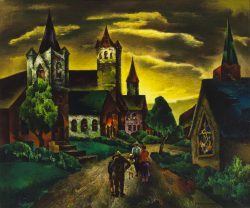William S. Schwartz, from an undated photograph, William S. Schwartz Papers, Archives of American Art, Smithsonian Institution, reel D59.

William S. Schwartz 1896-1977
William S. Schwartz was born into a poor Jewish family in Smorgon, Russia (now Smarhon’, Belarus), and at the age of just eleven began his art studies in Vilna (now Vilnius, Lithuania). Four years later he followed his siblings to the U.S., living briefly in New York and then in Omaha, Nebraska, where he painted houses and sold newspapers to make ends meet. Intent on further training, Schwartz moved to Chicago to enroll in the Art Institute of Chicago in 1916. A talented trained musician, Schwartz supported himself well into the 1920s by singing in opera, concerts, and vaudeville and on the radio, as well as working as a restaurant waiter and theater usher. His abilities as a visual artist were recognized early on, however: one of his paintings was accepted into the Art Institute’s annual “Chicago and Vicinity” exhibition in 1918, when he was still a student. The museum gave Schwartz solo exhibitions in 1926, 1929, and 1935. A book-length study of Schwartz was published in Chicago in 1930.
A multitalented as well as prolific artist, Schwartz created prints, sculptures, drawings, and murals in addition to watercolor and oil paintings. He was adept at landscape, still-life and figural imagery, portraiture, and abstraction. In his early work Schwartz often explored mythic themes using fractured forms, eccentric angles, and saturated color that recall among other modernist influences the paintings of his close friend Anthony Angarola. In the late 1920s Schwartz began to explore lithography, then lauded as a particularly democratic, accessible medium. He portrayed locales and people who were recognizably American, especially midwestern; Jewish themes and industrial and urban imagery also found a place in his art. Schwartz’s paintings of the 1930s and 1940s often evince a quiet melancholy, evoking what the Art Institute’s Daniel Catton Rich called “a reawakened Romanticism.”i
Schwartz’s individual style—characterized by graduated planes of mottled, textured tones edged with rhythmic, sometimes nervous lines—is fully on display in his so-called Symphonic Forms. In this long numbered series of abstract paintings, on which he worked from 1924 to 1967, the artist sought a visual equivalent for the aesthetic purity of music, which he declared his “second language.”ii Never lacking for recognition, Schwartz exhibited his works nationally and internationally and he won numerous prizes. By 1946, he was represented in a reported forty-five public collections across the country. Schwartz continued painting into the 1970s, working on the boundary between representation and abstraction.
Wendy Greenhouse, PhD
i Daniel Catton Rich, introduction to William S. Schwartz Exhibition: Paintings Water Colors (New York: Associated American Artists, [1943]), unpaged.
ii William S. Schwartz, “An Artist’s Love Affair with America,” Chicago Tribune Magazine, Apr. 5, 1970.
